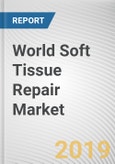The global soft tissue repair market is segmented on the basis of type, application and geography. According to type, the market is segmented into, Tissue Patch/Mesh such as Synthetic Mesh and Biological Mesh, Fixation Devices such as Suture Anchors, Interference Screw, Other Fixation Devices, and Laparoscopic Instruments. On the basis of application, the market is segmented into, Hernia Repair, Dural Repair, Breast Reconstruction, Skin Repair, Pelvic and Vaginal Prolapse repair, Orthopedic Repair and Dental Repair. Geographically, the market is segmented across four regions namely North America, Europe, Asia Pacific, and LAMEA. Acquisitions and product launch are some of the strategies adopted by key industry players. For instance, in Feb 2014, Smith & Nephew acquired ArthroCare Corp., a company engaged in the development of sports medicine and soft tissue repair products. Rotation Medical, has recently launched the Rotator Cuff Repair System with a bio inductive implant. The system is designed to induce the formation of new tendonous tissues, and is intended for use in mini-open and arthroscopic procedures. Similarly, Covidien, in Oct 2014, launched ReliaTack a laparoscopic, minimally invasive hernia repair device. The companies profiled in this report include, C.R Bard, Inc., Smith & Nephew plc, Wright Medical Group, Inc., Lifecell Corporation, Ethicon US, LLC., Arthrex, Inc., Lifenet Health, Inc., Medtronic plc, Integra Lifesciences Corporation and American Medical Systems Inc.
KEY MARKET BENEFITS
Comprehensive analysis of factors that drive and restrict the growth of the global soft tissue repair market is provided
The report provides a comprehensive analysis of the current market and estimations through 2014-2020, which would enable the stakeholders to capitalize on prevailing market opportunities
An in-depth analysis of key segments of the market demonstrate the types of devices along with the applications in the global soft tissue market
SWOT analysis highlights the internal environment of leading companies for effective strategy formulation
Region-wise soft tissue repair market scenario is comprehensively analysed in the report
Competitive intelligence highlights the business practises followed by leading market players across the geographies
KEY MARKET SEGMENT:
The global Soft Tissue Repair market is segmented below:
Soft Tissue Repair Market - By Type
Tissue Mesh
Biological Mesh
Allograft
Xenograft
Synthetic Mesh
Laparoscopic Instruments
Fixation Devices
Suture Anchors
Interference Screw
Other devices
Soft Tissue Repair Market - By Application
Breast Reconstruction
Dental Repair
Dural Repair
Head and Neck products
Hernia Repair
Orthopedic Repair
Pelvic and Vaginal Prolapse repair
Skin Repair
Soft Tissue Repair Market - By Geography
North America
Europe
Asia-Pacific
LAMEA
Methodology
The analyst offers exhaustive research and analysis based on a wide variety of factual inputs, which largely include interviews with industry participants, reliable statistics, and regional intelligence. The in-house industry experts play an instrumental role in designing analytic tools and models, tailored to the requirements of a particular industry segment. The primary research efforts include reaching out participants through mail, tele-conversations, referrals, professional networks, and face-to-face interactions.
They are also in professional corporate relations with various companies that allow them greater flexibility for reaching out to industry participants and commentators for interviews and discussions.
They also refer to a broad array of industry sources for their secondary research, which typically include; however, not limited to:
- Company SEC filings, annual reports, company websites, broker & financial reports, and investor presentations for competitive scenario and shape of the industry
- Scientific and technical writings for product information and related preemptions
- Regional government and statistical databases for macro analysis
- Authentic news articles and other related releases for market evaluation
- Internal and external proprietary databases, key market indicators, and relevant press releases for market estimates and forecast
Furthermore, the accuracy of the data will be analyzed and validated by conducting additional primaries with various industry experts and KOLs. They also provide robust post-sales support to clients.

LOADING...








